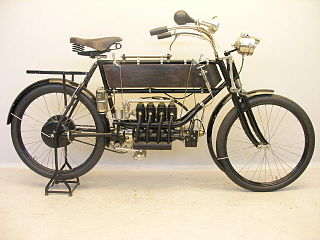
NSU Motorenwerke AG, or NSU, was a German manufacturer of automobiles, motorcycles and pedal cycles, founded in 1873. Acquired by Volkswagen Group in 1969, VW merged NSU with Auto Union, creating Audi NSU Auto Union AG, ultimately Audi. The name NSU originated as an abbreviation of "Neckarsulm", the city where NSU was located.

The Acme was a make of American automobiles made in Reading, Pennsylvania from 1903 to 1911. They were the successor of the Reber which was made from 1902 to 1903 by Reber Manufacturing.

L'Aster, Aster, Ateliers de Construction Mecanique l'Aster, was a French manufacturer of automobiles and the leading supplier of engines to other manufacturers from the late 1890s until circa 1910/12. Although primarily known as an engine mass manufacturer the company also produced chassis for coach-works and a complete range of components.

Laurin & Klement was a Czech automobile, motorcycle and bicycle manufacturing company founded in 1895 in Mladá Boleslav, Kingdom of Bohemia by automotive pioneers Václav Laurin and Václav Klement. Car production commenced in 1905, and the company soon became the largest car manufacturer in Austria-Hungary. It was acquired by industrial conglomerate Škoda Works in 1925 and re-branded as Škoda Auto, which is today the largest car manufacturer in the Czech Republic and a part of the Volkswagen Group.

The Dorris Motor Car Company was founded by George Preston Dorris in 1906. Born in Nashville, Tennessee, Dorris had built an experimental gasoline car circa 1896–1897 in his family's bicycle shop. He relocated to St. Louis, Missouri, where he joined with John L. French to found the St. Louis Motor Company. Dorris served as chief engineer.

E. R. Thomas Motor Company was a manufacturer of motorized bicycles, motorized tricycles, motorcycles, and automobiles in Buffalo, New York between 1900 and 1919.

Erwin George "Cannon Ball" Baker was an American motorcycle and automobile racing driver and organizer in the first half of the 20th century. Baker began his public career as a vaudeville performer, but turned to driving and racing after winning a dirt-track motorcycle race in Crawfordsville, Indiana, in about 1904.

A motorized bicycle is a bicycle with an attached motor or engine and transmission used either to power the vehicle unassisted, or to assist with pedalling. Since it sometimes retains both pedals and a discrete connected drive for rider-powered propulsion, the motorized bicycle is in technical terms a true bicycle, albeit a power-assisted one. Typically they are incapable of speeds above 52 km/h (32 mph).
The Calthorpe Motor Company based in Bordesley Green, Birmingham, England made a range of cars, motorcycles and bicycles from 1904 to 1932.

Larz Anderson Auto Museum is located in the Anderson Carriage House on the grounds of Larz Anderson Park in Brookline, Massachusetts and is the oldest collection of motorcars in the United States.

The Ner-A-Car was a type of feet forwards motorcycle designed by Carl Neracher in 1918. It used an unusual steel-channel chassis, much like an automobile, and hub-center steering at the front wheel, making it 'nearly a car' in design. The Ner-A-Car was the most successful hub-center steering motorcycle ever produced, with sales far eclipsing earlier or later examples of this design, such as the Yamaha GTS1000 or Bimota Tesi. About 10,000 Neracars were manufactured in the United States by the Ner-A-Car Corporation, while around 6,500 are believed to have been produced in England under licence by the Sheffield-Simplex company between 1921 and 1926 under the Ner-A-Car name.
The history of the motorcycle begins in the second half of the 19th century. Motorcycles are descended from the "safety bicycle," a bicycle with front and rear wheels of the same size and a pedal crank mechanism to drive the rear wheel. Despite some early landmarks in its development, the motorcycle lacks a rigid pedigree that can be traced back to a single idea or machine. Instead, the idea seems to have occurred to numerous engineers and inventors around Europe at around the same time.

Ernest "Ernie" Moross was an early-twentieth-century press agent and promoter specializing in American motorsports. He was a longtime associate of the first American auto racing superstar, Barney Oldfield. Moross also obtained distinction as the first Contest Director for the Indianapolis Motor Speedway. He left the Speedway in 1910 to campaign the Fiat racing team.

Tom Cooper was an American cyclist and early automobile racing driver. He is best known for his rivalry with cyclist Major Taylor, as well as his later work with Henry Ford and Barney Oldfield.
George Adams Wyman was the first person to make a transcontinental crossing of the United States by motor vehicle. In 1903, Wyman rode his 1902 California Motor Company motor bicycle from San Francisco to New York City in 51 days, finishing 20 days before Dr. Horatio Nelson Jackson, the first person to cross the continent by automobile.

The Auto-Bi was an early motorcycle made by the Thomas Motor Company in Buffalo, New York. According to many sources, it was the first motorcycle widely available for sale in the United States.

The FN Four was the world's first production inline-4 motorcycle, manufactured in Liége by Fabrique Nationale from 1905 until 1923. It was also, at 40 miles per hour (64 km/h), the world's fastest production motorcycle from 1911 until 1912.














